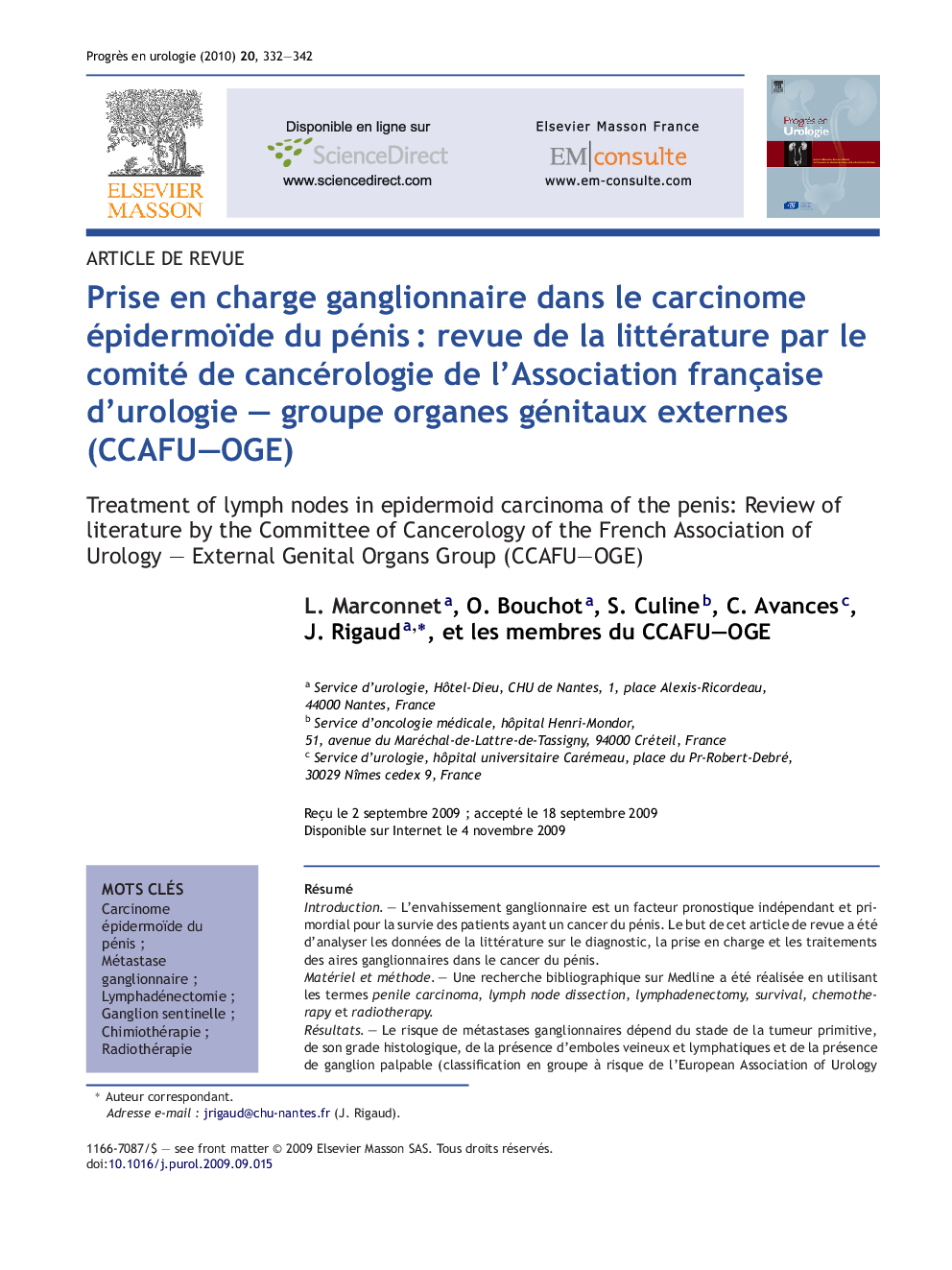| Article ID | Journal | Published Year | Pages | File Type |
|---|---|---|---|---|
| 3827143 | Progrès en Urologie | 2010 | 11 Pages |
RésuméIntroductionL’envahissement ganglionnaire est un facteur pronostique indépendant et primordial pour la survie des patients ayant un cancer du pénis. Le but de cet article de revue a été d’analyser les données de la littérature sur le diagnostic, la prise en charge et les traitements des aires ganglionnaires dans le cancer du pénis.Matériel et méthodeUne recherche bibliographique sur Medline a été réalisée en utilisant les termes penile carcinoma, lymph node dissection, lymphadenectomy, survival, chemotherapy et radiotherapy.RésultatsLe risque de métastases ganglionnaires dépend du stade de la tumeur primitive, de son grade histologique, de la présence d’emboles veineux et lymphatiques et de la présence de ganglion palpable (classification en groupe à risque de l’European Association of Urology [EAU]). Le diagnostic d’adénopathie suspecte est essentiellement basé sur l’examen clinique associé à la cytoponction. Aucun examen d’imagerie (tomodensitométrie, IRM, TEP-scanner) n’a prouvé sa supériorité par rapport à l’examen clinique. La recherche du ganglion sentinelle est intéressante mais reste encore à définir en particulier chez les patients n’ayant pas d’adénopathie palpée mais à risque de métastase. La chirurgie des aires inguinales est le seul moyen fiable pour confirmer un envahissement métastatique ganglionnaire mais elle a surtout un rôle curateur et pronostique chez les patients ayant une tumeur du pénis à risque d’atteinte ganglionnaire (risque intermédiaire ou élevé de l’EAU). Le geste doit toujours être bilatéral. Le type de curage est fonction de l’examen clinique de chaque côté : un curage inguinal total est indiqué en cas d’adénopathie palpée ; et un curage inguinal modifié est indiqué s’il n’est pas palpé d’adénopathie, il doit être totalisé en cas d’adénopathie métastatique lors de l’examen histologique. La chimiothérapie semble avoir une place intéressante associée à la chirurgie en situation néoadjuvante ou adjuvante, pour certains patients, sans qu’il y ait actuellement de consensus précis du fait du petit nombre de cas dans la littérature. De même pour la radiothérapie externe sur les aires inguinales qui semble avoir un probable intérêt pour le contrôle local de la maladie ganglionnaire mais en augmentant la morbidité du geste chirurgical.ConclusionLe curage ganglionnaire seul à un rôle thérapeutique curateur chez les patients ayant une atteinte métastatique d’un ganglion (stade pN1). Cependant, il demeure insuffisant chez les patients ayant une infiltration métastatique de plus de deux ganglions (stade ≥ pN2). Par conséquent, il semble important de développer des approches multimodales dans la prise en charge de ces patients afin d’augmenter le taux de réponse aux traitements.
SummaryIntroductionInvasive lymph nodes are an independent factor of prognosis and essential for the survival of patients with cancer of the penis. The aim of this article is to analyse published research results on the diagnosis and treatment of lymph nodes in cancer of the penis.Material and methodBibliographic research on Medline was carried out using the terms penile carcinoma, lymph node dissection, lymphadenectomy, survival, chemotherapy and radiotherapy.ResultsThe risk of lymph node metastasis depends on the stage of the primitive tumour, its histological grade, the presence of venous and lymphatic embolus and the presence of palpable lymph nodes (classification into risk groups by the European Association of Urology [EAU]). A diagnosis of suspected adenopathy based on clinical examination associated with FNA biopsy is essential. No medical imaging (tomodensitometry, NMR, PET-scan) has proven to be superior to clinical examination. The search for the sentinel lymph node although interesting remains to be defined, especially in patients who have no palpated adenopathy but are at risk of metastasis. Not only is surgery on inguinal lymph nodes the only reliable way of confirming an invasive metastatic lymph node, it also plays a therapeutic and prognositic role for patients who have a tumour of the penis which risks spreading to lymph nodes (intermediate or high risk according to EAU). The act should always be two-fold. The type of dissection is in function with the clinical examination: a radical inguinal dissection is recommended in the case of palpated adenopathy and a modified inguinal dissection is recommended if there is no palpated adenopathy, this should be radicalised in the case of metastatic adenopathy on histological examination. Neo-adjuvant or adjuvant chemotherapy would appear to play a interesting role when combined with surgery for certain patients without there being currently being precise consensus because of the lack of documented cases. The same goes for external radiotherapy on inguinal lymph nodes which seems to play a role in local controls of the lymph node disease though increases morbidity risks of surgical intervention.ConclusionLymph node dissection alone has a therapeutic role in patients who have reached metastasis of lymph nodes (stage pN1). However, it remains insufficient for patients who have metastatic infiltration of more than 2 lymph nodes (stage ≥ pN2). Consequently, it would seem important to develop multimodal approaches in the treatment of these patients in order to increase the rate of response to treatment.
